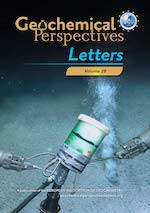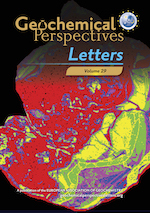207Pb-excess in carbonatitic baddeleyite as the result of Pa scavenging from the melt
Affiliations | Corresponding Author | Cite as | Funding information- Share this article





-
Article views:2,300Cumulative count of HTML views and PDF downloads.
- Download Citation
- Rights & Permissions
top
Abstract
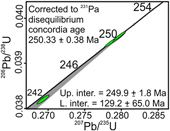
Figures
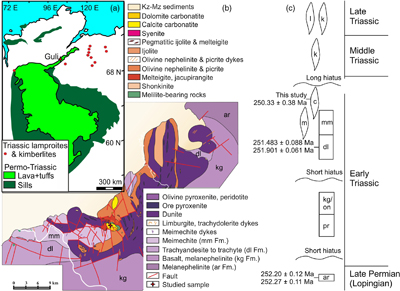 Figure 1 (a) Scheme of the Siberian Traps LIP (modified after Kogarko and Zartman, 2007). (b) Map of Guli volcanic-intrusive complex (Myshenkova et al., 2020). (c) Generalised stratigraphic relationships between volcanic and intrusive units at the Meimecha-Kotuy region (Ivanov et al., 2018b). High precision U-Pb dates are after Burgess and Bowring (2015) and this study (errors are 2σ analytical). Acronyms: ar – Arydzhansky Fm.; pr – Pravoboyarsky Fm.; kg/on – Kogotoksky Fm.; dl – Delkansky Fm.; mm – Meimechinsky Fm.; m – meimechite intrusions; c – carbonatite-bearing Guli complex; k and l – kimberlite and lamproite intrusions. | 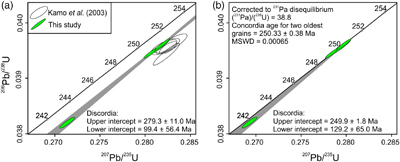 Figure 2 Concordia diagrams for Guli baddeleyite. (a) Green (new data), open symbols (Kamo et al., 2003). (b) Data corrected for 231Pa using decay constant of Jerome et al. (2020). The diagrams are plotted and ages calculated using IsoplotR (Vermeesch, 2018). Errors are 2σ analytical. | 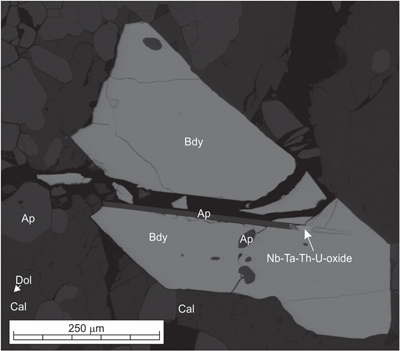 Figure 3 BSE image of a selected baddeleyite grain. Bdy – baddeleyite, Dol – dolomite, Cal – calcite, Ap – apatite, Nb-Ta-Th-U-oxide – unidentified phase (Table S-3). |
| Figure 1 | Figure 2 | Figure 3 |
top
Introduction
Precise 40Ar/39Ar and U-Pb dating has provided strong evidence for the rapidity of the most voluminous phase of large igneous province (LIP) magmatism. Such events typically last just a few million years or even less than a million years, although low volume eruptions may post-date voluminous magmatic pulses by ten or more million years (e.g., Siberian Traps; Burgess and Bowring, 2015
Burgess, S.D., Bowring, S.A. (2015) High-precision geochronology confirms voluminous magmatism before, during, and after Earth’s most severe extinction. Science Advances 1, e1500470.
; Ivanov et al., 2018aIvanov, A.V., Demonterova, E.I., Savatenkov, V.M., Perepelov, A.B., Ryabov, V.V., Shevko, A.Y. (2018a) Late Triassic (Carnian) lamproites from Noril’sk, polar Siberia: Evidence for melting of the recycled Archean crust and the question of lamproite source for some placer diamond deposits of the Siberian Craton. Lithos 296–299, 67–78.
). The Siberian Traps LIP (Fig. 1a) is the most voluminous among Phanerozoic continental LIPs (Ivanov, 2007Ivanov, A.V. (2007) Evaluation of different models for the origin of the Siberian traps. In: Foulger, G.R., Jurdy, D.M. (Eds.) The origin of melting anomalies: plates, plumes and planetary processes. Special Paper 430, Geological Society of America, Boulder, Colorado, 669–692.
) and is considered as the cause of the most pronounced terrestrial Permian-Triassic mass extinction (Erwin et al., 2002Erwin, D.H., Bowring, S.A., Yugan, J. (2002) End-permian mass extinctions: A review. In: Koeberl, C., MacLeod, K.G. (Eds.) Catastrophic events and mass extinctions: Impacts and beyond. Special Paper 356, Geological Society of America, Boulder, Colorado, 363–383.
). Thus, the timing and duration of the Siberian Traps LIP are of particular interest for the Earth Sciences.
Figure 1 (a) Scheme of the Siberian Traps LIP (modified after Kogarko and Zartman, 2007
Kogarko, L.N., Zartman, R.E. (2007) A Pb isotope investigation of the Guli massif, Maymecha-Kotuy alkaline-ultramafic complex, Siberian flood basalt province, Polar Siberia. Mineralogy and Petrology 89, 113–132.
). (b) Map of Guli volcanic-intrusive complex (Myshenkova et al., 2020Myshenkova, M.S., Zaitsev, V.A., Thomson, S., Latyshev, A.V., Zakharov, V.S., Bagdasaryan, T.E., Veselovsky, R.V. (2020) Thermal history of the Guli Pluton (North of the Siberian Platform) according to apatite fission-track dating and computer modeling. Geodynamics & Tectonophysics 11, 75–87.
). (c) Generalised stratigraphic relationships between volcanic and intrusive units at the Meimecha-Kotuy region (Ivanov et al., 2018bIvanov, A.V., Mukasa, S.B., Kamenetsky, V.S., Ackerson, M., Demonterova, E.I., Pokrovsky, B.G., Vladykin, N.V., Kolesnichenko, M.V., Litasov, K.D., Zedgenizov, D.A. (2018b) Volatile concentrations in olivine-hosted melt inclusions from meimechite and melanephelinite lavas of the Siberian Traps Large Igneous Province: Evidence for flux-related high-Ti, high-Mg magmatism. Chemical Geology 483, 442–462.
). High precision U-Pb dates are after Burgess and Bowring (2015)Burgess, S.D., Bowring, S.A. (2015) High-precision geochronology confirms voluminous magmatism before, during, and after Earth’s most severe extinction. Science Advances 1, e1500470.
and this study (errors are 2σ analytical). Acronyms: ar – Arydzhansky Fm.; pr – Pravoboyarsky Fm.; kg/on – Kogotoksky Fm.; dl – Delkansky Fm.; mm – Meimechinsky Fm.; m – meimechite intrusions; c – carbonatite-bearing Guli complex; k and l – kimberlite and lamproite intrusions.Nearly twenty years ago, Kamo et al. (2003)
Kamo, S.L., Czamanske, G.K., Amelin, Y., Fedorenko, V.A., Davis, D.W., Trofimov, V.R. (2003) Rapid eruption of Siberian flood-volcanic rocks and evidence for coincidence with the Permian-Triassic boundary and mass extinction at 251 Ma. Earth and Planetary Science Letters 214, 75–91.
bracketed the voluminous phase of magmatism of the Siberian Traps LIP between the U-Pb dates of 251.7 ± 0.4 Ma and 250.2 ± 0.3 Ma. These dates were obtained, respectively, from perovskite in melanephelinite in the lowermost, so called Arydzhansky Formation, and baddeleyite from carbonatite, in the uppermost, so called Guli volcanic-intrusive complex (Fig. 1b,c). A stratigraphically consistent U-Pb date of 251.1 ± 0.3 Ma for zircon from trachyrhyodacite in the intermediate Delkansky Formation was also reported (Kamo et al., 2003Kamo, S.L., Czamanske, G.K., Amelin, Y., Fedorenko, V.A., Davis, D.W., Trofimov, V.R. (2003) Rapid eruption of Siberian flood-volcanic rocks and evidence for coincidence with the Permian-Triassic boundary and mass extinction at 251 Ma. Earth and Planetary Science Letters 214, 75–91.
). The analytical method was at that time state of the art isotope dilution thermal ionisation mass spectrometry (ID-TIMS). A later determination of the age of the Arydzhansky and Delkansky Formations with high precision U-Pb ID-TIMS geochronology by Burgess and Bowring (2015)Burgess, S.D., Bowring, S.A. (2015) High-precision geochronology confirms voluminous magmatism before, during, and after Earth’s most severe extinction. Science Advances 1, e1500470.
, gave slightly older perovskite dates of 252.20 ± 0.12 Ma and 252.27 ± 0.11 Ma for the Arydzhansky Formation, and slightly older zircon dates of 251.901 ± 0.061 Ma and 251.483 ± 0.088 Ma for the Delkansky Formation (here errors are 2σ internal analytical for the reason explained below). Subsequent geochronology of the Guli carbonatites by Malich et al. (2015)Malich, K.N., Khiller, V.V., Badanina, I.Y., Belousova, E.A. (2015) Results of dating of thorianite and baddeleyite from carbonatites of the Guli massif, Russia. Doklady Earth Sciences 464, 1029–1032.
, using chemical microprobe dating of thorianite and laser ablation inductively coupled plasma mass spectrometry (LA-ICPMS) dating of baddeleyite, obtained dates consistent with Kamo et al. (2003)Kamo, S.L., Czamanske, G.K., Amelin, Y., Fedorenko, V.A., Davis, D.W., Trofimov, V.R. (2003) Rapid eruption of Siberian flood-volcanic rocks and evidence for coincidence with the Permian-Triassic boundary and mass extinction at 251 Ma. Earth and Planetary Science Letters 214, 75–91.
. The methods of Malich et al. (2015)Malich, K.N., Khiller, V.V., Badanina, I.Y., Belousova, E.A. (2015) Results of dating of thorianite and baddeleyite from carbonatites of the Guli massif, Russia. Doklady Earth Sciences 464, 1029–1032.
were, however, unable to yield precisions better than ±1 Ma, at best, which is comparable with the expected total duration of the voluminous phases of LIP magmatism.The reason to re-assess the Kamo et al. (2003)
Kamo, S.L., Czamanske, G.K., Amelin, Y., Fedorenko, V.A., Davis, D.W., Trofimov, V.R. (2003) Rapid eruption of Siberian flood-volcanic rocks and evidence for coincidence with the Permian-Triassic boundary and mass extinction at 251 Ma. Earth and Planetary Science Letters 214, 75–91.
data is because the U-Pb results for the dated baddeleyite grains were discordant and the age was calculated from the 206Pb/238U ratio with the assumption that the discordance resulted from unsupported 207Pb. In this study, we provide additional higher precision U-Pb ID-TIMS dating results on baddeleyite of the Guli carbonatite and discuss the relevance of the unsupported 207Pb explanation.top
Geological Setting
The Guli complex is the largest alkaline-ultramafic complex on a global scale. It has an exposed area of about 470 km2, but magnetic and gravimetric anomalies suggest an overall extension of 1500 km2 (Egorov, 1991
Egorov, L.S. (1991) Iyolite-carbonatite plutonism. Nedra, Moscow.
). The complex is composed of variable mafic alkaline and ultramafic rocks and carbonatites (Fig. 1b). Carbonatites form two stocks (named plugs in Kamo et al., 2003Kamo, S.L., Czamanske, G.K., Amelin, Y., Fedorenko, V.A., Davis, D.W., Trofimov, V.R. (2003) Rapid eruption of Siberian flood-volcanic rocks and evidence for coincidence with the Permian-Triassic boundary and mass extinction at 251 Ma. Earth and Planetary Science Letters 214, 75–91.
), a southern and a northern one, each about 4.5 km2 in size (Fig. 1b). The studied sample (GU-70) is from the southern stock. It is composed of calcite, apatite and magnetite, subordinate phlogopite and accessory baddeleyite. Apatite and magnetite form strips of different orientation (Fig. S-1). Baddeleyite is found as well formed crystals of dark brown colour up to 0.5 mm in size.top
Methods
Baddeleyite grains and their mineral inclusions were imaged using an Alpha 300r confocal Raman spectrometer and scanning electron microscope (SEM) Hitachi SU-70 supplemented by an energy dispersive X-ray spectrometer of Oxford Instruments for chemical analysis. Apatite grains were analysed for 207Pb/206Pb and 238U/206Pb ratios by LA-ICPMS on an Agilent 7900 quadrupole ICP-MS coupled to a Coherent COMPex Pro 110 utilising an ArF excimer laser operating at the 193 nm wavelength and a pulse width of ∼20 ns. A RESOlution/ Laurin Technic S155 constant geometry ablation cell was used. Calibration of the 207Pb/206Pb ratio was done using analyses of the NIST610 reference glass analysed at the same conditions as the unknowns. Following the procedure of Thompson et al. (2016)
Thompson, J., Meffre, S., Maas, R., Kamenetsky, V., Kamenetsky, M., Goemann, K., Ehrig, K., Danyushevsky, L. (2016) Matrix effects in Pb/U measurements during LA-ICP-MS analysis of the mineral apatite. Journal of Analytical Atomic Spectrometry 31, 1206–1215.
, the OD306 apatite was used as a primary in house geochronology reference material for calibration of Pb/U ratios and to correct for instrument drift. The Durango, McClure Mountain and 401 apatites were employed as secondary geochronology reference materials (Table S-1).The baddeleyite grains processed for U-Pb dating were dark brown fragments, opaque to marginally translucent. They were first air abraded (Krogh, 1982
Krogh, T.E. (1982) Improved accuracy of U-Pb zircon ages by the creation of more concordant systems using an air abrasion technique. Geochimica et Cosmochimica Acta 46, 637–649.
), then cleaned in warm HNO3 for 20 minutes and rinsed with H2O and acetone. The grains were weighed and transferred to a Krogh-type teflon bomb, with the addition of HF and HNO3 (12∶1) and a 202Pb-205Pb-235U spike. The spike composition has been harmonised with that of the EARTHTIME ET2535 spike (Corfu et al., 2016Corfu, F., Svensen, H., Mazzini, A. (2016) Comment to paper: Evaluating the temporal link between the Karoo LIP and climatic-biologic events of the Toarcian Stage with high-precision U–Pb geochronology by Bryan Sell, Maria Ovtcharova, Jean Guex, Annachiara Bartolini, Fred Jourdan, Jorge E. Spangenberg, Jean-Claude Vicente, Urs Schaltegger in Earth and Planetary Science Letters 408 (2014) 48–56. Earth and Planetary Science Letters 434, 349–352.
) used by Burgess and Bowring (2015)Burgess, S.D., Bowring, S.A. (2015) High-precision geochronology confirms voluminous magmatism before, during, and after Earth’s most severe extinction. Science Advances 1, e1500470.
. Dissolution occurred at 195 °C for 5 days, followed by one night at 195 °C in 3N HCl, and chemical separation in ion exchange resin. The solution with Pb and U was loaded on outgassed Re filaments with silica gel and H3PO4 and measured with a MAT262 mass spectrometer. Blank correction was 2 pg Pb and 0.1 pg U, the remaining common Pb was corrected using a composition calculated with the Stacey and Kramers (1975)Stacey, J.S., Kramers, J.D. (1975) Approximation of terrestrial lead isotope evolution by a two-stage model. Earth and Planetary Science Letters 26, 207–221.
model for the age of the sample (Table S-2). The ages were calculated using the decay constants of Jaffey et al. (1971)Jaffey, A.H., Flynn, K.F., Glendenin, L.E., Bentley, W.C., Essling, A.M. (1971) Precision measurement of half-lives and specific activities of 235U and 238U. Physical Review C 4, 1889–1906.
and 238U/235U = 137.88, and were not corrected for 230Th disequilibrium.top
Results and Discussion
The results for the Guli baddeleyite are plotted in a concordia diagram together with those obtained previously by Kamo et al. (2003)
Kamo, S.L., Czamanske, G.K., Amelin, Y., Fedorenko, V.A., Davis, D.W., Trofimov, V.R. (2003) Rapid eruption of Siberian flood-volcanic rocks and evidence for coincidence with the Permian-Triassic boundary and mass extinction at 251 Ma. Earth and Planetary Science Letters 214, 75–91.
(Fig. 2a). Three of the new analyses are clustered together close to previous analyses but the fourth is distinctly younger, indicating Pb loss. The reason for this behaviour is likely due to inclusions of another U-rich mineral as suggested by the higher level of U and initial Pb, and higher Th/U of this analysis (Table S-2). Such a mineral – Ta-Nb-Th-U-oxide was imaged by SEM (Fig. 3, Table S-3). Other common mineral inclusions are apatites (Figs. 3, S-2).
Figure 2 Concordia diagrams for Guli baddeleyite. (a) Green (new data), open symbols (Kamo et al., 2003
Kamo, S.L., Czamanske, G.K., Amelin, Y., Fedorenko, V.A., Davis, D.W., Trofimov, V.R. (2003) Rapid eruption of Siberian flood-volcanic rocks and evidence for coincidence with the Permian-Triassic boundary and mass extinction at 251 Ma. Earth and Planetary Science Letters 214, 75–91.
). (b) Data corrected for 231Pa using decay constant of Jerome et al. (2020)Jerome, S., Bobin, C., Cassette, P., Dersch, R., Galea, R., Liu, H., Honig, A., Keightley, J., Kossert, K., Liang, J., Marouli, M., Michotte, C., Pomme, S., Rottger, S., Williams, R., Zhang, M. (2020) Half-life determination and comparison of activity standards of 231Pa. Applied Radiation and Isotopes 155, 108837.
. The diagrams are plotted and ages calculated using IsoplotR (Vermeesch, 2018Vermeesch, P. (2018) IsoplotR: A free and open toolbox for geochronology. Geoscience Frontiers 9, 1479–1493.
). Errors are 2σ analytical.
Figure 3 BSE image of a selected baddeleyite grain. Bdy – baddeleyite, Dol – dolomite, Cal – calcite, Ap – apatite, Nb-Ta-Th-U-oxide – unidentified phase (Table S-3).
A discordia line can be drawn through the new, more precise data (Fig. 2a). It yields an upper intercept with concordia of 279.3 ± 11.0 Ma. However, this cannot reflect the true age of Guli carbonatite. It is too old relative to the date of thorianite (250.1 ± 2.9 Ma; Malich et al., 2015
Malich, K.N., Khiller, V.V., Badanina, I.Y., Belousova, E.A. (2015) Results of dating of thorianite and baddeleyite from carbonatites of the Guli massif, Russia. Doklady Earth Sciences 464, 1029–1032.
) and to the host volcanic rocks (Fig. 1c).All U-Pb data points are located to the right of concordia. This cannot be due to an incorrect correction of common lead because the ratio of radiogenic to common Pb is very high and, in addition, the initial 207Pb/206Pb in apatite, the most probable source of common lead in baddeleyite, is equal within uncertainty to that obtained with the Stacey and Kramers (1975)
Stacey, J.S., Kramers, J.D. (1975) Approximation of terrestrial lead isotope evolution by a two-stage model. Earth and Planetary Science Letters 26, 207–221.
model (Fig. S-3). Thus, discordance of baddeleyite is real.To explain such discordant baddeleyite data, Kamo et al. (2003)
Kamo, S.L., Czamanske, G.K., Amelin, Y., Fedorenko, V.A., Davis, D.W., Trofimov, V.R. (2003) Rapid eruption of Siberian flood-volcanic rocks and evidence for coincidence with the Permian-Triassic boundary and mass extinction at 251 Ma. Earth and Planetary Science Letters 214, 75–91.
assumed unsupported 207Pb, which accumulated from an excess of 231Pa inherited by baddeleyite during its crystallisation from carbonatite magma. The 231Pa-235U disequilibrium required for the explanation of the discordant Guli baddeleyite data can be calculated as follows: the upper (231Pa)/(235U) value is constrained by the reasoning that the analyses should not be reversely discordant and the positive discordance cannot be such as to make the upper intercept of the discordia line older than the age of the Delkansky Formation (Fig. 1c). Using these constraints for the new, more precise data, (231Pa)/(235U) falls in the range between ∼39.6 and 35.6. Assuming no loss of radiogenic lead for the two oldest grains and (231Pa)/(235U) = 38.8 (the value with the lowest MSWD) we obtain a concordia age of 250.33 ± 0.38 Ma (Fig. 2b). (Note: this age stays practically the same for a wide range of (231Pa)/(235U) values). Considering that the Nd isotope composition of Guli carbonatites (ɛNdT = +4.9; Kogarko and Zartman, 2007Kogarko, L.N., Zartman, R.E. (2007) A Pb isotope investigation of the Guli massif, Maymecha-Kotuy alkaline-ultramafic complex, Siberian flood basalt province, Polar Siberia. Mineralogy and Petrology 89, 113–132.
) agrees only with that of meimechites (+4.5 to + 5.7; Ivanov et al., 2018bIvanov, A.V., Mukasa, S.B., Kamenetsky, V.S., Ackerson, M., Demonterova, E.I., Pokrovsky, B.G., Vladykin, N.V., Kolesnichenko, M.V., Litasov, K.D., Zedgenizov, D.A. (2018b) Volatile concentrations in olivine-hosted melt inclusions from meimechite and melanephelinite lavas of the Siberian Traps Large Igneous Province: Evidence for flux-related high-Ti, high-Mg magmatism. Chemical Geology 483, 442–462.
), the age for the Guli baddeleyite may characterise the timing of emplacement of voluminous meimechite lavas.Drawing a discordia line through the (231Pa)/(235U) corrected data yields the lower intercept age of 129.2 ± 65.0 Ma. This fits well with the timing of the Early Cretaceous large scale rifting event that occurred in the vast region of Central and East Asia (Wang et al., 2011
Wang, T., Zheng, Y.D., Zhang, J.J., Zeng, L.S., Donskaya, T., Guo, L., Li, J.B. (2011) Pattern and kinematic polarity of Late Mesozoic extension in continental NE Asia: Perspectives from metamorphic core complexes. Tectonics 30, TC6007.
).The 231Pa-235U disequilibrium required for the explanation of the discordant Guli baddeleyite data by unsupported 207Pb is not the largest among values suggested in other studies. For example, a study of Kovdor carbonatite-bearing massif suggests that (231Pa)/(235U) up to 100 can explain the discordance of baddeleyite data from this massif by unsupported 207Pb (Amelin and Zaitsev, 2002
Amelin, Y., Zaitsev, A.N. (2002) Precise geochronology of phoscorites and carbonatites: The critical role of U-series disequilibrium in age interpretations. Geochimica et Cosmochimica Acta 66, 2399–2419.
). To our knowledge, only one study exists which analysed (231Pa)/(235U) directly in very young baddeleyite (Sun et al., 2020Sun, Y., Schmitt, A.K., Pappalardo, L., Russo, M. (2020) Quantification of excess 231Pa in late Quaternary igneous baddeleyite. American Mineralogist 105, 1830–1840.
). In that study, baddeleyite from Holocene syenite in the Vesuvius and Laacher See volcanoes requires (231Pa)/(235U) between 3 and 15. The most pronounced (231Pa)/(235U) suggested disequilibrium reaches 1,100 in zircon of Oligocene pegmatite in Pakistan’s Himalaya (Anczkiewicz et al., 2001Anczkiewicz, R., Oberli, F., Burg, J.P., Villa, I.M., Gunther, D., Meier, M. (2001) Timing of normal faulting along the Indus Suture in Pakistan Himalaya and a case of major 231Pa/235U initial disequilibrium in zircon. Earth and Planetary Science Letters 191, 101–114.
).The largest negative 231Pa-235U disequilibrium for igneous suites was recorded in the Oldoinyo Lengai volcano with (231Pa)/(235U) of ∼0.2 in carbonatite melts (Peate and Hawkesworth, 2005
Peate, D.W., Hawkesworth, C.J. (2005) U series disequilibria: Insights into mantle melting and the timescales of magma differentiation. Reviews in Geophysics 43, RG1003.
). In order to explain the positive and negative disequilibrium (231Pa)/(235U) values in baddeleyite and carbonatite melt, respectively, we need to accept that protactinium, compared to uranium, goes preferentially to baddeleyite, which is a typical early crystallising phase of carbonatites. No baddeleyite has ever been found in Oldoinyo Lengai natrocarbonatites, suggesting it could accumulate at the base of the magma chamber leaving the erupting carbonatite with low (231Pa)/(235U). Accumulation of baddeleyite agrees with the very low Zr concentrations in Oldoinyo Lengai natrocarbonatites (<32 μg/g) relative to associated silicate alkaline melts (>317 μg/g) (Simonetti et al., 1997Simonetti, A., Bell, K., Shrady, C. (1997) Trace- and rare-earth-element geochemistry of the June 1993 natrocarbonatite lavas, Oldoinyo Lengai (Tanzania): Implications for the origin of carbonatite magmas. Journal of Volcanology and Geothermal Research 75, 89–106.
; Jung et al., 2019Jung, S.G., Choi, S.H., Ji, K.H., Ryu, J.-S., Lee, D.-C. (2019) Geochemistry of volcanic rocks from Oldoinyo Lengai, Tanzania: Implications for mantle source lithology. Lithos 350, 105223.
).top
Conclusions
Our new data concur with the idea that discordance of carbonatitic baddeleyite results from the presence of unsupported 207Pb and agree with a previously published date for the Guli carbonatite by Kamo et al. (2003)
Kamo, S.L., Czamanske, G.K., Amelin, Y., Fedorenko, V.A., Davis, D.W., Trofimov, V.R. (2003) Rapid eruption of Siberian flood-volcanic rocks and evidence for coincidence with the Permian-Triassic boundary and mass extinction at 251 Ma. Earth and Planetary Science Letters 214, 75–91.
. A (231Pa)/(235U) of 39.6–35.6 is required to explain the discordant baddeleyite data. The high 207Pb excess in baddeleyite implies that much protactinium is scavenged by crystallising baddeleyite, leaving the magma depleted in this element, as shown in carbonatitic magma such as at Oldoinyo Lengai. The total duration of the voluminous phase of the Siberian Traps LIP magmatism can be estimated from the period between the mean of two dates reported by Burgess and Bowring (2015)Burgess, S.D., Bowring, S.A. (2015) High-precision geochronology confirms voluminous magmatism before, during, and after Earth’s most severe extinction. Science Advances 1, e1500470.
of 252.24 ± 0.08 Ma for the Arydzhansky formation and the preferred date of 250.33 ± 0.38 Ma for Guli carbonatite (errors are analytical because the two data sets are obtained with mutually homogenised isotopic tracers). This duration amounts to 1.91 ± 0.38 million years.top
Acknowledgements
This is the contribution to the grant 075-15-2019-1883. We thank Axel Schmitt and anonymous reviewer for useful suggestions and Horst Marschall for editorial handling.
Editor: Horst R. Marschall
top
References
Amelin, Y., Zaitsev, A.N. (2002) Precise geochronology of phoscorites and carbonatites: The critical role of U-series disequilibrium in age interpretations. Geochimica et Cosmochimica Acta 66, 2399–2419.
 Show in context
Show in context For example, a study of Kovdor carbonatite-bearing massif suggests that (231Pa)/(235U) up to 100 can explain the discordance of baddeleyite data from this massif by unsupported 207Pb (Amelin and Zaitsev, 2002).
View in article
Anczkiewicz, R., Oberli, F., Burg, J.P., Villa, I.M., Gunther, D., Meier, M. (2001) Timing of normal faulting along the Indus Suture in Pakistan Himalaya and a case of major 231Pa/235U initial disequilibrium in zircon. Earth and Planetary Science Letters 191, 101–114.
 Show in context
Show in context The most pronounced (231Pa)/(235U) suggested disequilibrium reaches 1,100 in zircon of Oligocene pegmatite in Pakistan’s Himalaya (Anczkiewicz et al., 2001).
View in article
Burgess, S.D., Bowring, S.A. (2015) High-precision geochronology confirms voluminous magmatism before, during, and after Earth’s most severe extinction. Science Advances 1, e1500470.
 Show in context
Show in context Such events typically last just a few million years or even less than a million years, although low volume eruptions may post-date voluminous magmatic pulses by ten or more million years (e.g., Siberian Traps; Burgess and Bowring, 2015; Ivanov et al., 2018a).
View in article
High precision U-Pb dates are after Burgess and Bowring (2015) and this study (errors are 2σ analytical).
View in article
A later determination of the age of the Arydzhansky and Delkansky Formations with high precision U-Pb ID-TIMS geochronology by Burgess and Bowring (2015), gave slightly older perovskite dates of 252.20 ± 0.12 Ma and 252.27 ± 0.11 Ma for the Arydzhansky Formation, and slightly older zircon dates of 251.901 ± 0.061 Ma and 251.483 ± 0.088 Ma for the Delkansky Formation (here errors are 2σ internal analytical for the reason explained below).
View in article
The spike composition has been harmonised with that of the EARTHTIME ET2535 spike (Corfu et al., 2016) used by Burgess and Bowring (2015).
View in article
The total duration of the voluminous phase of the Siberian Traps LIP magmatism can be estimated from the period between the mean of two dates reported by Burgess and Bowring (2015) of 252.24 ± 0.08 Ma for the Arydzhansky formation and the preferred date of 250.33 ± 0.38 Ma for Guli carbonatite (errors are analytical because the two data sets are obtained with mutually homogenised isotopic tracers).
View in article
Corfu, F., Svensen, H., Mazzini, A. (2016) Comment to paper: Evaluating the temporal link between the Karoo LIP and climatic-biologic events of the Toarcian Stage with high-precision U–Pb geochronology by Bryan Sell, Maria Ovtcharova, Jean Guex, Annachiara Bartolini, Fred Jourdan, Jorge E. Spangenberg, Jean-Claude Vicente, Urs Schaltegger in Earth and Planetary Science Letters 408 (2014) 48–56. Earth and Planetary Science Letters 434, 349–352.
 Show in context
Show in context The spike composition has been harmonised with that of the EARTHTIME ET2535 spike (Corfu et al., 2016) used by Burgess and Bowring (2015).
View in article
Egorov, L.S. (1991) Iyolite-carbonatite plutonism. Nedra, Moscow.
 Show in context
Show in context It has an exposed area of about 470 km2, but magnetic and gravimetric anomalies suggest an overall extension of 1500 km2 (Egorov, 1991).
View in article
Erwin, D.H., Bowring, S.A., Yugan, J. (2002) End-permian mass extinctions: A review. In: Koeberl, C., MacLeod, K.G. (Eds.) Catastrophic events and mass extinctions: Impacts and beyond. Special Paper 356, Geological Society of America, Boulder, Colorado, 363–383.
 Show in context
Show in context The Siberian Traps LIP (Fig. 1a) is the most voluminous among Phanerozoic continental LIPs (Ivanov, 2007) and is considered as the cause of the most pronounced terrestrial Permian-Triassic mass extinction (Erwin et al., 2002).
View in article
Ivanov, A.V. (2007) Evaluation of different models for the origin of the Siberian traps. In: Foulger, G.R., Jurdy, D.M. (Eds.) The origin of melting anomalies: plates, plumes and planetary processes. Special Paper 430, Geological Society of America, Boulder, Colorado, 669–692.
 Show in context
Show in context The Siberian Traps LIP (Fig. 1a) is the most voluminous among Phanerozoic continental LIPs (Ivanov, 2007) and is considered as the cause of the most pronounced terrestrial Permian-Triassic mass extinction (Erwin et al., 2002).
View in article
Ivanov, A.V., Demonterova, E.I., Savatenkov, V.M., Perepelov, A.B., Ryabov, V.V., Shevko, A.Y. (2018a) Late Triassic (Carnian) lamproites from Noril’sk, polar Siberia: Evidence for melting of the recycled Archean crust and the question of lamproite source for some placer diamond deposits of the Siberian Craton. Lithos 296–299, 67–78.
 Show in context
Show in context Such events typically last just a few million years or even less than a million years, although low volume eruptions may post-date voluminous magmatic pulses by ten or more million years (e.g., Siberian Traps; Burgess and Bowring, 2015; Ivanov et al., 2018a).
View in article
Ivanov, A.V., Mukasa, S.B., Kamenetsky, V.S., Ackerson, M., Demonterova, E.I., Pokrovsky, B.G., Vladykin, N.V., Kolesnichenko, M.V., Litasov, K.D., Zedgenizov, D.A. (2018b) Volatile concentrations in olivine-hosted melt inclusions from meimechite and melanephelinite lavas of the Siberian Traps Large Igneous Province: Evidence for flux-related high-Ti, high-Mg magmatism. Chemical Geology 483, 442–462.
 Show in context
Show in context (c) Generalised stratigraphic relationships between volcanic and intrusive units at the Meimecha-Kotuy region (Ivanov et al., 2018b).
View in article
Considering that the Nd isotope composition of Guli carbonatites (ɛNdT = +4.9; Kogarko and Zartman, 2007) agrees only with that of meimechites (+4.5 to + 5.7; Ivanov et al., 2018b), the age for the Guli baddeleyite may characterise the timing of emplacement of voluminous meimechite lavas.
View in article
Jaffey, A.H., Flynn, K.F., Glendenin, L.E., Bentley, W.C., Essling, A.M. (1971) Precision measurement of half-lives and specific activities of 235U and 238U. Physical Review C 4, 1889–1906.
 Show in context
Show in context The ages were calculated using the decay constants of Jaffey et al. (1971) and 238U/235U = 137.88, and were not corrected for 230Th disequilibrium.
View in article
Jerome, S., Bobin, C., Cassette, P., Dersch, R., Galea, R., Liu, H., Honig, A., Keightley, J., Kossert, K., Liang, J., Marouli, M., Michotte, C., Pomme, S., Rottger, S., Williams, R., Zhang, M. (2020) Half-life determination and comparison of activity standards of 231Pa. Applied Radiation and Isotopes 155, 108837.
 Show in context
Show in context (b) Data corrected for 231Pa using decay constant of Jerome et al. (2020).
View in article
Jung, S.G., Choi, S.H., Ji, K.H., Ryu, J.-S., Lee, D.-C. (2019) Geochemistry of volcanic rocks from Oldoinyo Lengai, Tanzania: Implications for mantle source lithology. Lithos 350, 105223.
 Show in context
Show in context Accumulation of baddeleyite agrees with the very low Zr concentrations in Oldoinyo Lengai natrocarbonatites (<32 μg/g) relative to associated silicate alkaline melts (>317 μg/g) (Simonetti et al., 1997; Jung et al., 2019).
View in article
Kamo, S.L., Czamanske, G.K., Amelin, Y., Fedorenko, V.A., Davis, D.W., Trofimov, V.R. (2003) Rapid eruption of Siberian flood-volcanic rocks and evidence for coincidence with the Permian-Triassic boundary and mass extinction at 251 Ma. Earth and Planetary Science Letters 214, 75–91.
 Show in context
Show in context Nearly twenty years ago, Kamo et al. (2003) bracketed the voluminous phase of magmatism of the Siberian Traps LIP between the U-Pb dates of 251.7 ± 0.4 Ma and 250.2 ± 0.3 Ma.
View in article
A stratigraphically consistent U-Pb date of 251.1 ± 0.3 Ma for zircon from trachyrhyodacite in the intermediate Delkansky Formation was also reported (Kamo et al., 2003).
View in article
Subsequent geochronology of the Guli carbonatites by Malich et al. (2015), using chemical microprobe dating of thorianite and laser ablation inductively coupled plasma mass spectrometry (LA-ICPMS) dating of baddeleyite, obtained dates consistent with Kamo et al. (2003).
View in article
The reason to re-assess the Kamo et al. (2003) data is because the U-Pb results for the dated baddeleyite grains were discordant and the age was calculated from the 206Pb/238U ratio with the assumption that the discordance resulted from unsupported 207Pb.
View in article
Carbonatites form two stocks (named plugs in Kamo et al., 2003), a southern and a northern one, each about 4.5 km2 in size (Fig. 1b).
View in article
The results for the Guli baddeleyite are plotted in a concordia diagram together with those obtained previously by Kamo et al. (2003) (Fig. 2a).
View in article
(a) Green (new data), open symbols (Kamo et al., 2003).
View in article
To explain such discordant baddeleyite data, Kamo et al. (2003) assumed unsupported 207Pb, which accumulated from an excess of 231Pa inherited by baddeleyite during its crystallisation from carbonatite magma.
View in article
Our new data concur with the idea that discordance of carbonatitic baddeleyite results from the presence of unsupported 207Pb and agree with a previously published date for the Guli carbonatite by Kamo et al. (2003).
View in article
Kogarko, L.N., Zartman, R.E. (2007) A Pb isotope investigation of the Guli massif, Maymecha-Kotuy alkaline-ultramafic complex, Siberian flood basalt province, Polar Siberia. Mineralogy and Petrology 89, 113–132.
 Show in context
Show in context (a) Scheme of the Siberian Traps LIP (modified after Kogarko and Zartman, 2007).
View in article
Considering that the Nd isotope composition of Guli carbonatites (ɛNdT = +4.9; Kogarko and Zartman, 2007) agrees only with that of meimechites (+4.5 to + 5.7; Ivanov et al., 2018b), the age for the Guli baddeleyite may characterise the timing of emplacement of voluminous meimechite lavas.
View in article
Krogh, T.E. (1982) Improved accuracy of U-Pb zircon ages by the creation of more concordant systems using an air abrasion technique. Geochimica et Cosmochimica Acta 46, 637–649.
 Show in context
Show in context They were first air abraded (Krogh, 1982), then cleaned in warm HNO3 for 20 minutes and rinsed with H2O and acetone.
View in article
Malich, K.N., Khiller, V.V., Badanina, I.Y., Belousova, E.A. (2015) Results of dating of thorianite and baddeleyite from carbonatites of the Guli massif, Russia. Doklady Earth Sciences 464, 1029–1032.
 Show in context
Show in context Subsequent geochronology of the Guli carbonatites by Malich et al. (2015), using chemical microprobe dating of thorianite and laser ablation inductively coupled plasma mass spectrometry (LA-ICPMS) dating of baddeleyite, obtained dates consistent with Kamo et al. (2003).
View in article
The methods of Malich et al. (2015) were, however, unable to yield precisions better than ±1 Ma, at best, which is comparable with the expected total duration of the voluminous phases of LIP magmatism.
View in article
It is too old relative to the date of thorianite (250.1 ± 2.9 Ma; Malich et al., 2015) and to the host volcanic rocks (Fig. 1c).
View in article
Myshenkova, M.S., Zaitsev, V.A., Thomson, S., Latyshev, A.V., Zakharov, V.S., Bagdasaryan, T.E., Veselovsky, R.V. (2020) Thermal history of the Guli Pluton (North of the Siberian Platform) according to apatite fission-track dating and computer modeling. Geodynamics & Tectonophysics 11, 75–87.
 Show in context
Show in context (b) Map of Guli volcanic-intrusive complex (Myshenkova et al., 2020).
View in article
Peate, D.W., Hawkesworth, C.J. (2005) U series disequilibria: Insights into mantle melting and the timescales of magma differentiation. Reviews in Geophysics 43, RG1003.
 Show in context
Show in context The largest negative 231Pa-235U disequilibrium for igneous suites was recorded in the Oldoinyo Lengai volcano with (231Pa)/(235U) of ∼0.2 in carbonatite melts (Peate and Hawkesworth, 2005).
View in article
Simonetti, A., Bell, K., Shrady, C. (1997) Trace- and rare-earth-element geochemistry of the June 1993 natrocarbonatite lavas, Oldoinyo Lengai (Tanzania): Implications for the origin of carbonatite magmas. Journal of Volcanology and Geothermal Research 75, 89–106.
 Show in context
Show in context Accumulation of baddeleyite agrees with the very low Zr concentrations in Oldoinyo Lengai natrocarbonatites (<32 μg/g) relative to associated silicate alkaline melts (>317 μg/g) (Simonetti et al., 1997; Jung et al., 2019).
View in article
Stacey, J.S., Kramers, J.D. (1975) Approximation of terrestrial lead isotope evolution by a two-stage model. Earth and Planetary Science Letters 26, 207–221.
 Show in context
Show in context Blank correction was 2 pg Pb and 0.1 pg U, the remaining common Pb was corrected using a composition calculated with the Stacey and Kramers (1975) model for the age of the sample (Table S-2).
View in article
This cannot be due to an incorrect correction of common lead because the ratio of radiogenic to common Pb is very high and, in addition, the initial 207Pb/206Pb in apatite, the most probable source of common lead in baddeleyite, is equal within uncertainty to that obtained with the Stacey and Kramers (1975) model (Fig. S-3).
View in article
Sun, Y., Schmitt, A.K., Pappalardo, L., Russo, M. (2020) Quantification of excess 231Pa in late Quaternary igneous baddeleyite. American Mineralogist 105, 1830–1840.
 Show in context
Show in context To our knowledge, only one study exists which analysed (231Pa)/(235U) directly in very young baddeleyite (Sun et al., 2020).
View in article
Thompson, J., Meffre, S., Maas, R., Kamenetsky, V., Kamenetsky, M., Goemann, K., Ehrig, K., Danyushevsky, L. (2016) Matrix effects in Pb/U measurements during LA-ICP-MS analysis of the mineral apatite. Journal of Analytical Atomic Spectrometry 31, 1206–1215.
 Show in context
Show in context Following the procedure of Thompson et al. (2016), the OD306 apatite was used as a primary in house geochronology reference material for calibration of Pb/U ratios and to correct for instrument drift.
View in article
Vermeesch, P. (2018) IsoplotR: A free and open toolbox for geochronology. Geoscience Frontiers 9, 1479–1493.
 Show in context
Show in context The diagrams are plotted and ages calculated using IsoplotR (Vermeesch, 2018).
View in article
Wang, T., Zheng, Y.D., Zhang, J.J., Zeng, L.S., Donskaya, T., Guo, L., Li, J.B. (2011) Pattern and kinematic polarity of Late Mesozoic extension in continental NE Asia: Perspectives from metamorphic core complexes. Tectonics 30, TC6007.
 Show in context
Show in context This fits well with the timing of the Early Cretaceous large scale rifting event that occurred in the vast region of Central and East Asia (Wang et al., 2011).
View in article
top
Supplementary Information
The Supplementary Information includes:
- Supplementary Tables S-1 to S-3
- Supplementary Figures S-1 to S-3
- Supplementary Information References
Download Table S-1 (Excel).
Download the Supplementary Information (PDF).
Figures
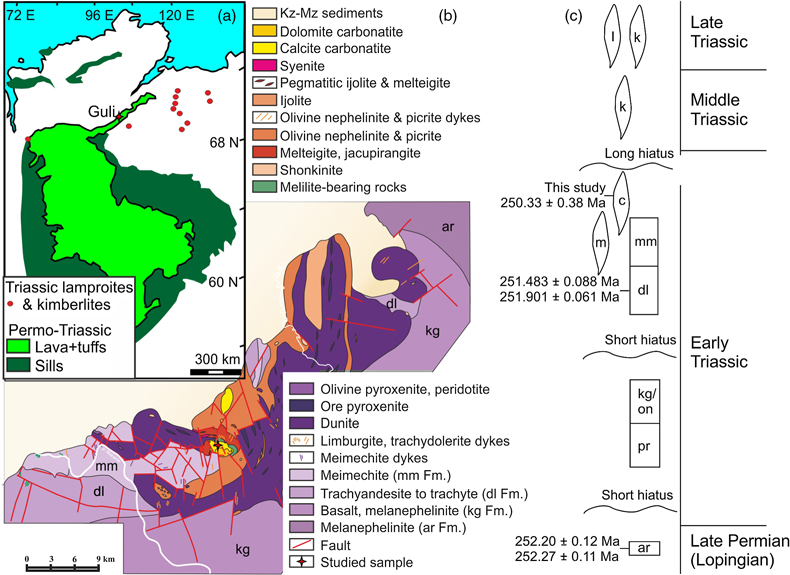
Figure 1 (a) Scheme of the Siberian Traps LIP (modified after Kogarko and Zartman, 2007
Kogarko, L.N., Zartman, R.E. (2007) A Pb isotope investigation of the Guli massif, Maymecha-Kotuy alkaline-ultramafic complex, Siberian flood basalt province, Polar Siberia. Mineralogy and Petrology 89, 113–132.
). (b) Map of Guli volcanic-intrusive complex (Myshenkova et al., 2020Myshenkova, M.S., Zaitsev, V.A., Thomson, S., Latyshev, A.V., Zakharov, V.S., Bagdasaryan, T.E., Veselovsky, R.V. (2020) Thermal history of the Guli Pluton (North of the Siberian Platform) according to apatite fission-track dating and computer modeling. Geodynamics & Tectonophysics 11, 75–87.
). (c) Generalised stratigraphic relationships between volcanic and intrusive units at the Meimecha-Kotuy region (Ivanov et al., 2018bIvanov, A.V., Mukasa, S.B., Kamenetsky, V.S., Ackerson, M., Demonterova, E.I., Pokrovsky, B.G., Vladykin, N.V., Kolesnichenko, M.V., Litasov, K.D., Zedgenizov, D.A. (2018b) Volatile concentrations in olivine-hosted melt inclusions from meimechite and melanephelinite lavas of the Siberian Traps Large Igneous Province: Evidence for flux-related high-Ti, high-Mg magmatism. Chemical Geology 483, 442–462.
). High precision U-Pb dates are after Burgess and Bowring (2015)Burgess, S.D., Bowring, S.A. (2015) High-precision geochronology confirms voluminous magmatism before, during, and after Earth’s most severe extinction. Science Advances 1, e1500470.
and this study (errors are 2σ analytical). Acronyms: ar – Arydzhansky Fm.; pr – Pravoboyarsky Fm.; kg/on – Kogotoksky Fm.; dl – Delkansky Fm.; mm – Meimechinsky Fm.; m – meimechite intrusions; c – carbonatite-bearing Guli complex; k and l – kimberlite and lamproite intrusions.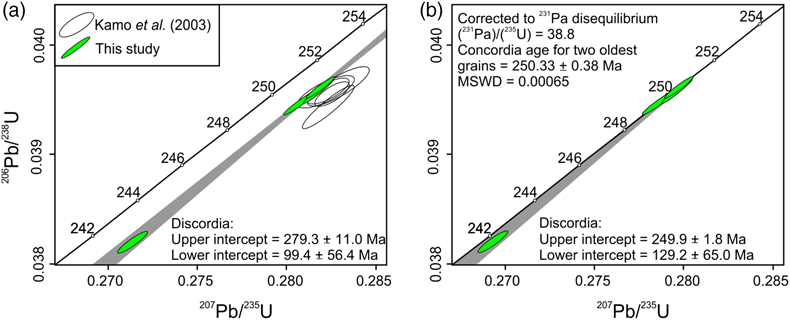
Figure 2 Concordia diagrams for Guli baddeleyite. (a) Green (new data), open symbols (Kamo et al., 2003
Kamo, S.L., Czamanske, G.K., Amelin, Y., Fedorenko, V.A., Davis, D.W., Trofimov, V.R. (2003) Rapid eruption of Siberian flood-volcanic rocks and evidence for coincidence with the Permian-Triassic boundary and mass extinction at 251 Ma. Earth and Planetary Science Letters 214, 75–91.
). (b) Data corrected for 231Pa using decay constant of Jerome et al. (2020)Jerome, S., Bobin, C., Cassette, P., Dersch, R., Galea, R., Liu, H., Honig, A., Keightley, J., Kossert, K., Liang, J., Marouli, M., Michotte, C., Pomme, S., Rottger, S., Williams, R., Zhang, M. (2020) Half-life determination and comparison of activity standards of 231Pa. Applied Radiation and Isotopes 155, 108837.
. The diagrams are plotted and ages calculated using IsoplotR (Vermeesch, 2018Vermeesch, P. (2018) IsoplotR: A free and open toolbox for geochronology. Geoscience Frontiers 9, 1479–1493.
). Errors are 2σ analytical.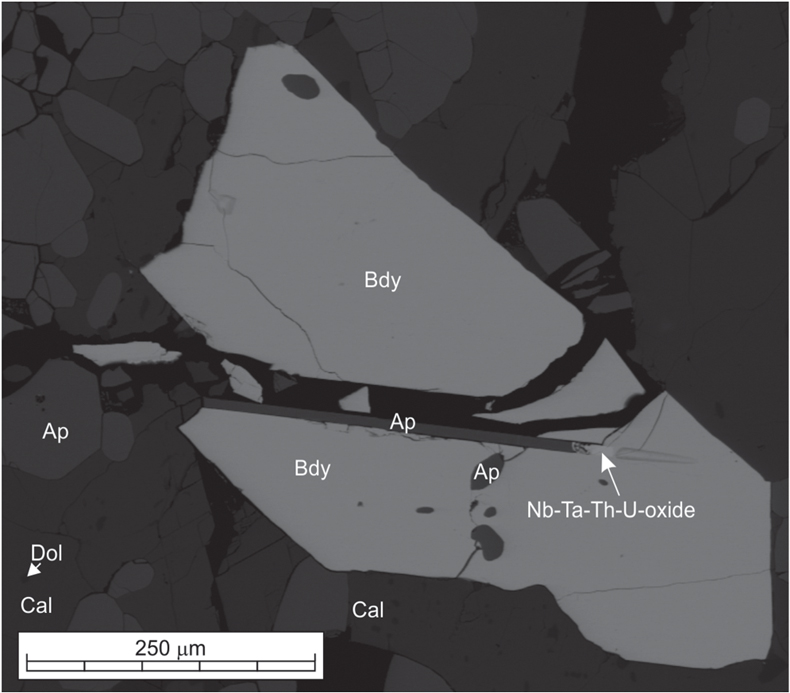
Figure 3 BSE image of a selected baddeleyite grain. Bdy – baddeleyite, Dol – dolomite, Cal – calcite, Ap – apatite, Nb-Ta-Th-U-oxide – unidentified phase (Table S-3).



